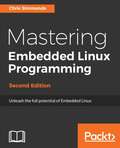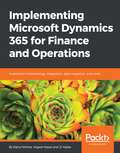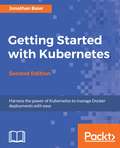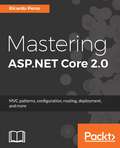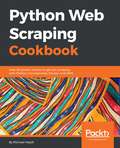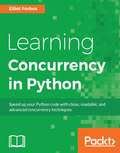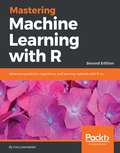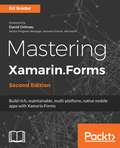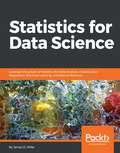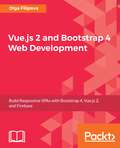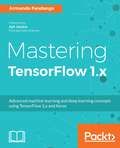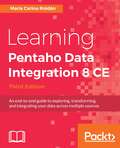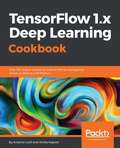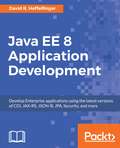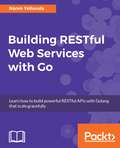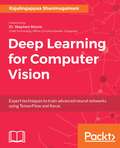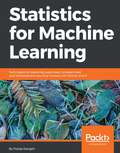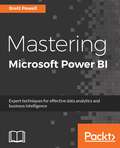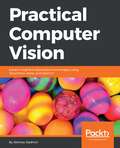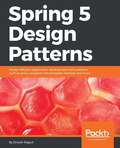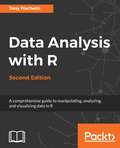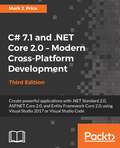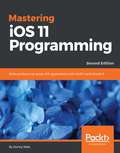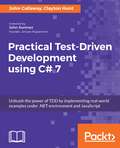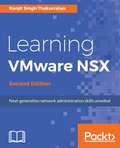- Table View
- List View
Mastering Embedded Linux Programming – Second Edition
by Chris SimmondsLinux is a highly-respected open source operating system that can scale from small devices to large supercomputers. This book describes how to employ Linux at the bottom end of the scale to create efficient, secure, and cost-effective products.
Implementing Microsoft Dynamics 365 for Finance and Operations
by Yogesh Kasat Jj Yadav Rahul MohtaHarness the power of Dynamics 365 Operations and discover all you need to implement it About This Book • Master all the necessary tools and resources to evaluate Dynamics 365 for Operations, implement it, and proactively maintain it. • Troubleshoot your problems effectively with your Dynamics 365 partner • Learn about architecture, deployment choices, integration, configuration and data migration, development, testing, reporting and BI, support, upgrading, and more. Who This Book Is For This book is for technology leaders, project managers solution architects, and consultants who are planning to implement, are in the process of implementing, or are currently upgrading to Dynamics 365 for Operations. This book will help you effectively learn and implement Dynamics 365 for Operations. What You Will Learn • Learn about Microsoft Dynamics 365, it's offerings, plans and details of Finance and Operations, Enterprise edition • Understand the methodology and the tool, architecture, and deployment options • Effectively plan and manage configurations and data migration, functional design, and technical design • Understand integration frameworks, development concepts, best practices, and recommendations while developing new solutions • Learn how to leverage intelligence and analytics through Power BI, machine learning, IOT, and Cortana intelligence • Master testing, training, going live, upgrading, and how to get support during and after the implementation In Detail Microsoft Dynamics 365 for Finance and Operations, Enterprise edition, is a modern, cloud-first, mobile-first, ERP solution suitable for medium and large enterprise customers. This book will guide you through the entire life cycle of a implementation, helping you avoid common pitfalls while increasing your efficiency and effectiveness at every stage of the project. Starting with the foundations, the book introduces the Microsoft Dynamics 365 offerings, plans, and products. You will be taken through the various methodologies, architectures, and deployments so you can select, implement, and maintain Microsoft Dynamics 365 for Finance and Operations, Enterprise edition. You will delve in-depth into the various phases of implementation: project management, analysis, configuration, data migration, design, development, using Power BI, machine learning, Cortana analytics for intelligence, testing, training, and finally deployment, support cycles, and upgrading. This book focuses on providing you with information about the product and the various concepts and tools, along with real-life examples from the field and guidance that will empower you to execute and implement Dynamics 365 for Finance and Operations, Enterprise edition. Style and approach This book is a step-by-step guide focusing on implementing Dynamics 365 Operations solutions for your organization.
Getting Started with Kubernetes - Second Edition
by Jonathan BaierLearn how to schedule and run application containers using Kubernetes. About This Book • Get well-versed with the fundamentals of Kubernetes and get it production-ready for deployments • Confidently manage your container clusters and networks using Kubernetes • This practical guide will show you container application examples throughout to illustrate the concepts and features of Kubernetes Who This Book Is For This book is for developers, sys admins, and DevOps engineers who want to automate the deployment process and scale their applications. You do not need any knowledge about Kubernetes. What You Will Learn • Download, install, and configure the Kubernetes codebase • Understand the core concepts of a Kubernetes cluster • Be able to set up and access monitoring and logging for Kubernetes clusters • Set up external access to applications running in the cluster • Understand how CoreOS and Kubernetes can help you achieve greater performance and container implementation agility • Run multiple clusters and manage from a single control plane • Explore container security as well as securing Kubernetes clusters • Work with third-party extensions and tools In Detail Kubernetes has continued to grow and achieve broad adoption across various industries, helping you to orchestrate and automate container deployments on a massive scale. This book will give you a complete understanding of Kubernetes and how to get a cluster up and running. You will develop an understanding of the installation and configuration process. The book will then focus on the core Kubernetes constructs such as pods, services, replica sets, replication controllers, and labels. You will also understand how cluster level networking is done in Kubernetes. The book will also show you how to manage deployments and perform updates with minimal downtime. Additionally, you will learn about operational aspects of Kubernetes such as monitoring and logging. Advanced concepts such as container security and cluster federation will also be covered. Finally, you will learn about the wider Kubernetes ecosystem with OCP, CoreOS, and Tectonic and explore the third-party extensions and tools that can be used with Kubernetes. By the end of the book, you will have a complete understanding of the Kubernetes platform and will start deploying applications on it. Style and approach This straightforward guide will help you understand how to move your container applications into production through best practices and a step-by-step walkthrough tied to real-world operational strategies.
Mastering ASP.NET Core 2.0
by Ricardo PeresBecome an expert in the shiny new version of ASP.NET About This Book • Grasp the advanced concepts of MVC Core and start making professional-grade applications • Migrate from previous versions of ASP.NET MVC to ASP.NET Core • This book will take you on a journey through all the aspects of ASP.NET Core 2.0 Who This Book Is For If you are a developer who knows the basics of ASP.NET MVC and wants to build powerful applications, this book is for you. Basic C# experience and an understanding of HTML and CSS is assumed. What You Will Learn • Get to know the new features of ASP.NET Core 2.0 • Find out how to configure ASP.NET Core • Configure routes to access ASP.NET Core resources • Create controllers and action methods and see how to maintain the state • Create views to display contents • Implement and validate forms and retrieve information from them • Write reusable modules for ASP.NET Core • Deploy ASP.NET Core to other environments In Detail ASP.NET is an open source web framework that builds modern web apps and services. This book is your one-stop guide to the new features of ASP.NET Core 2.0, including web APIs and MVC. We begin with a brief overview of the basics, taking you through the MVC pattern, platforms, dependencies, and frameworks. We then move on to setting up and configuring the MVC environment before talking about routing and advanced routing options. Next, we'll look at model binding, controllers and actions, filters, user authentication, and testing. Moving on, you'll learn about all the aspects of syntax and processes when working with Razor. You'll be introduced to client-side development and will get to know about the security aspects of ASP.NET Core. We will also look at microservices with ASP.NET Core. Finally, you'll find out how to deploy ASP.NET Core to new environments such as Azure, AWS, and Docker. By the end of the book, you will be well versed with development in ASP.NET Core and will have a deep understanding of how to interact with the framework and work cross-platform. Style and approach Find out how to design modern, cross-platform, business oriented web applications that serve the client needs in the age of emerging .NET framework
Python Web Scraping Cookbook: Over 90 Proven Recipes To Get You Scraping With Python, Micro Services, Docker And Aws
by Michael HeydtPython Web Scraping Cookbook is a solution-focused book that will teach you techniques to develop high-performance Scrapers, and deal with cookies, hidden form fields, Ajax-based sites, proxies, and more. By the end of this book, you will be able to scrape websites more efficiently with more accurate data, and how to package, deploy and operate scrapers in the cloud.
Learning Concurrency in Python
by Elliot ForbesPractically and deeply understand concurrency in Python to write efficient programs About This Book • Build highly efficient, robust, and concurrent applications • Work through practical examples that will help you address the challenges of writing concurrent code • Improve the overall speed of execution in multiprocessor and multicore systems and keep them highly available Who This Book Is For This book is for Python developers who would like to get started with concurrent programming. Readers are expected to have a working knowledge of the Python language, as this book will build on these fundamentals concepts. What You Will Learn • Explore the concept of threading and multiprocessing in Python • Understand concurrency with threads • Manage exceptions in child threads • Handle the hardest part in a concurrent system — shared resources • Build concurrent systems with Communicating Sequential Processes (CSP) • Maintain all concurrent systems and master them • Apply reactive programming to build concurrent systems • Use GPU to solve specific problems In Detail Python is a very high level, general purpose language that is utilized heavily in fields such as data science and research, as well as being one of the top choices for general purpose programming for programmers around the world. It features a wide number of powerful, high and low-level libraries and frameworks that complement its delightful syntax and enable Python programmers to create. This book introduces some of the most popular libraries and frameworks and goes in-depth into how you can leverage these libraries for your own high-concurrent, highly-performant Python programs. We'll cover the fundamental concepts of concurrency needed to be able to write your own concurrent and parallel software systems in Python. The book will guide you down the path to mastering Python concurrency, giving you all the necessary hardware and theoretical knowledge. We'll cover concepts such as debugging and exception handling as well as some of the most popular libraries and frameworks that allow you to create event-driven and reactive systems. By the end of the book, you'll have learned the techniques to write incredibly efficient concurrent systems that follow best practices. Style and approach This easy-to-follow guide teaches you new practices and techniques to optimize your code, and then moves toward more advanced ways to effectively write efficient Python code. Small and simple practical examples will help you test the concepts yourself, and you will be able to easily adapt them for any application.
Mastering Machine Learning with R - Second Edition
by Cory LesmeisterMaster machine learning techniques with R to deliver insights in complex projects About This Book • Understand and apply machine learning methods using an extensive set of R packages such as XGBOOST • Understand the benefits and potential pitfalls of using machine learning methods such as Multi-Class Classification and Unsupervised Learning • Implement advanced concepts in machine learning with this example-rich guide Who This Book Is For This book is for data science professionals, data analysts, or anyone with a working knowledge of machine learning, with R who now want to take their skills to the next level and become an expert in the field. What You Will Learn • Gain deep insights into the application of machine learning tools in the industry • Manipulate data in R efficiently to prepare it for analysis • Master the skill of recognizing techniques for effective visualization of data • Understand why and how to create test and training data sets for analysis • Master fundamental learning methods such as linear and logistic regression • Comprehend advanced learning methods such as support vector machines • Learn how to use R in a cloud service such as Amazon In Detail This book will teach you advanced techniques in machine learning with the latest code in R 3.3.2. You will delve into statistical learning theory and supervised learning; design efficient algorithms; learn about creating Recommendation Engines; use multi-class classification and deep learning; and more. You will explore, in depth, topics such as data mining, classification, clustering, regression, predictive modeling, anomaly detection, boosted trees with XGBOOST, and more. More than just knowing the outcome, you'll understand how these concepts work and what they do. With a slow learning curve on topics such as neural networks, you will explore deep learning, and more. By the end of this book, you will be able to perform machine learning with R in the cloud using AWS in various scenarios with different datasets. Style and approach The book delivers practical and real-world solutions to problems and a variety of tasks such as complex recommendation systems. By the end of this book, you will have gained expertise in performing R machine learning and will be able to build complex machine learning projects using R and its packages.
Mastering Xamarin.Forms.: Build Rich, Maintainable, Multi-platform, Native Mobile Apps With Xamarin. Forms
by Ed SniderDiscover how to extend and build upon the components of the Xamarin.Forms toolkit to develop an effective, robust mobile app architecture. Starting with an app built with the basics of the Xamarin.Forms toolkit, you'll go step by step through several advanced topics to create a solution architecture rich with the benefits of good design patterns and best practices.
Statistics for Data Science
by James D. MillerGet your statistics basics right before diving into the world of data science About This Book • No need to take a degree in statistics, read this book and get a strong statistics base for data science and real-world programs; • Implement statistics in data science tasks such as data cleaning, mining, and analysis • Learn all about probability, statistics, numerical computations, and more with the help of R programs Who This Book Is For This book is intended for those developers who are willing to enter the field of data science and are looking for concise information of statistics with the help of insightful programs and simple explanation. Some basic hands on R will be useful. What You Will Learn • Analyze the transition from a data developer to a data scientist mindset • Get acquainted with the R programs and the logic used for statistical computations • Understand mathematical concepts such as variance, standard deviation, probability, matrix calculations, and more • Learn to implement statistics in data science tasks such as data cleaning, mining, and analysis • Learn the statistical techniques required to perform tasks such as linear regression, regularization, model assessment, boosting, SVMs, and working with neural networks • Get comfortable with performing various statistical computations for data science programmatically In Detail Data science is an ever-evolving field, which is growing in popularity at an exponential rate. Data science includes techniques and theories extracted from the fields of statistics; computer science, and, most importantly, machine learning, databases, data visualization, and so on. This book takes you through an entire journey of statistics, from knowing very little to becoming comfortable in using various statistical methods for data science tasks. It starts off with simple statistics and then move on to statistical methods that are used in data science algorithms. The R programs for statistical computation are clearly explained along with logic. You will come across various mathematical concepts, such as variance, standard deviation, probability, matrix calculations, and more. You will learn only what is required to implement statistics in data science tasks such as data cleaning, mining, and analysis. You will learn the statistical techniques required to perform tasks such as linear regression, regularization, model assessment, boosting, SVMs, and working with neural networks. By the end of the book, you will be comfortable with performing various statistical computations for data science programmatically. Style and approach Step by step comprehensive guide with real world examples
Vue.js 2 and Bootstrap 4 Web Development
by Olga FilipovaLearn how to combine Bootstrap with Vue.js to build responsive web applications. About This Book • Build applications with a good architecture and clean UI with Vue.js and Bootstrap • Understand Bootstrap components and learn to integrate them with the Vue.js structure • Build, deploy, and test your code with various utility tools provided by Vue.js Who This Book Is For This book is for JavaScript programmers who are new to web frameworks and want to start learning it by developing interactive and responsive web applications. What You Will Learn • Create and build web applications using Vue.js, Webpack, and Nuxt.js • Combine Bootstrap components with Vue.js' power to enrich your web applications with reusable elements • Connect the Vuex state management architecture to the Firebase cloud backend to persist and manage application data • Explore the new grid system of Bootstrap 4 along with the far simpler directives in Vue.js • Test Vue applications using Jest • Authenticate your application using Bootstrap's forms, Vue.js' reactivity, and Firebase's authentication API • Deploy your application using Firebase, which provides Backend as a Service In Detail In this book, we will build a full stack web application right from scratch up to its deployment. We will start by building a small introduction application and then proceed to the creation of a fully functional, dynamic responsive web application called ProFitOro. In this application, we will build a Pomodoro timer combined with office workouts. Besides the Pomodoro timer and ProFitOro workouts will enable authentication and collaborative content management. We will explore topics such as Vue reactive data binding, reusable components, routing, and Vuex store along with its state, actions, mutations, and getters. We will create Vue applications using both webpack and Nuxt.js templates while exploring cool hot Nuxt.js features such as code splitting and server-side rendering. We will use Jest to test this application, and we will even revive some trigonometry from our secondary school! While developing the app, you will go through the new grid system of Bootstrap 4 along with Vue.js' directives. We will connect Vuex store to the Firebase real-time database, data storage, and authentication APIs and use this data later inside the application's reactive components. Finally, we will quickly deploy our application using the Firebase hosting mechanism. Style and Approach Step-by-step tutorial
Mastering TensorFlow 1.x: Advanced Machine Learning And Deep Learning Concepts Using Tensorflow 1. X And Keras
by Armando FandangoWe cover advanced deep learning concepts (such as transfer learning, generative adversarial models, and reinforcement learning), and implement them using TensorFlow and Keras. We cover how to build and deploy at scale with distributed models. You will learn to build TensorFlow models using R, Keras, TensorFlow Learn, TensorFlow Slim and Sonnet
Learning Pentaho Data Integration 8 CE - Third Edition
by Maria Carina RoldanGet up and running with the Pentaho Data Integration tool using this hands-on, easy-to-read guide About This Book • Manipulate your data by exploring, transforming, validating, and integrating it using Pentaho Data Integration 8 CE • A comprehensive guide exploring the features of Pentaho Data Integration 8 CE • Connect to any database engine, explore the databases, and perform all kind of operations on relational databases Who This Book Is For This book is a must-have for software developers, business intelligence analysts, IT students, or anyone involved or interested in developing ETL solutions. If you plan on using Pentaho Data Integration for doing any data manipulation task, this book will help you as well. This book is also a good starting point for data warehouse designers, architects, or anyone who is responsible for data warehouse projects and needs to load data into them. What You Will Learn • Explore the features and capabilities of Pentaho Data Integration 8 Community Edition • Install and get started with PDI • Learn the ins and outs of Spoon, the graphical designer tool • Learn to get data from all kind of data sources, such as plain files, Excel spreadsheets, databases, and XML files • Use Pentaho Data Integration to perform CRUD (create, read, update, and delete) operations on relationaldatabases • Populate a data mart with Pentaho Data Integration • Use Pentaho Data Integration to organize files and folders, run daily processes, deal with errors, and more In Detail Pentaho Data Integration(PDI) is an intuitive and graphical environment packed with drag-and-drop design and powerful Extract-Tranform-Load (ETL) capabilities. This book shows and explains the new interactive features of Spoon, the revamped look and feel, and the newest features of the tool including transformations and jobs Executors and the invaluable Metadata Injection capability. We begin with the installation of PDI software and then move on to cover all the key PDI concepts. Each of the chapter introduces new features, enabling you to gradually get practicing with the tool. First, you will learn to do all kind of data manipulation and work with simple plain files. Then, the book teaches you how you can work with relational databases inside PDI. Moreover, you will be given a primer on data warehouse concepts and you will learn how to load data in a data warehouse. During the course of this book, you will be familiarized with its intuitive, graphical and drag-and-drop design environment. By the end of this book, you will learn everything you need to know in order to meet your data manipulation requirements. Besides, your will be given best practices and advises for designing and deploying your projects. Style and approach Step by step guide filled with practical, real world scenarios and examples.
TensorFlow 1.x Deep Learning Cookbook
by Antonio GulliIn this book, you will learn how to efficiently use TensorFlow, Google's open source framework for deep learning. You will implement different deep learning networks such as Convolutional Neural Networks (CNNs), Recurrent Neural Networks (RNNs), Deep Q-learning Networks (DQNs), and Generative Adversarial Networks (GANs) with easy to follow independent recipes.
Java EE 8 Application Development
by David R. HeffelfingerDevelop Enterprise Java applications compliant with the latest version of the Java EE specification About This Book • This book covers all of the major Java EE 8 APIs and includes new additions such as enhanced Security, JSON-B Processing, and more • Learn additional Java EE APIs, such as the Java API for Websocket and the Java Message Service (JMS) • Develop applications by taking advantage of the latest versions of CDI, Security, Servlets, and JSF and other Java EE specifications Who This Book Is For If you are a Java developer who wants to become proficient with Java EE 8, this book is ideal for you. You are expected to have some experience with Java and to have developed and deployed applications in the past, but you don't need any previous knowledge of Java EE. What You Will Learn • Develop and deploy Java EE applications • Embrace the latest additions to the Contexts and Dependency Injection (CDI) specification to develop Java EE applications • Develop web-based applications by utilizing the latest version of JavaServer Faces, JSF 2.3. • Understand the steps needed to process JSON data with JSON-P and the new JSON-B Java EE API • Implement RESTful web services using the new JAX-RS 2.1 API, which also includes support for Server-Sent Events (SSE) and the new reactive client API In Detail Java EE is an Enterprise Java standard. Applications written to comply with the Java EE specification do not tie developers to a specific vendor; instead they can be deployed to any Java EE compliant application server. With this book, you'll get all the tools and techniques you need to build robust and scalable applications in Java EE 8. This book covers all the major Java EE 8 APIs including JSF 2.3, Enterprise JavaBeans (EJB) 3.2, Contexts and Dependency Injection (CDI) 2.0, the Java API for WebSockets, JAX-RS 2.1, Servlet 4.0, and more. The book begins by introducing you to Java EE 8 application development and goes on to cover all the major Java EE 8 APIs. It goes beyond the basics to develop Java EE applications that can be deployed to any Java EE 8 compliant application server. It also introduces advanced topics such as JSON-P and JSON-B, the Java APIs for JSON processing, and the Java API for JSON binding. These topics dive deep, explaining how the two APIs (the Model API and the Streaming API) are used to process JSON data. Moving on, we cover additional Java EE APIs, such as the Java API for Websocket and the Java Message Service (JMS), which allows loosely coupled, asynchronous communication. Further on, you'll discover ways to secure Java EE applications by taking advantage of the new Java EE Security API. Finally, you'll learn more about the RESTful web service development using the latest JAX-RS 2.1 specification. You'll also get to know techniques to develop cloud-ready microservices in Java EE. Style and approach The book takes a pragmatic approach, showing you various techniques to utilize new features of Java EE 8 specification. It is packed with clear, step-by-step instructions, practical examples, and straightforward explanations.
Building RESTful Web services with Go: Learn how to build powerful RESTful APIs with Golang that scale gracefully
by Anshul Joshi Naren YellavulaKey Features Follow best practices and explore techniques such as clustering and caching to achieve a reactive, scalable web service Leverage the Buffalo Framework to quickly implement RESTful endpoints Learn to implement a client library for a RESTful web service using Go Book Description REST is an architectural style that tackles the challenges of building scalable web services and in today's connected world, APIs have taken a central role on the web. APIs provide the fabric through which systems interact, and REST has become synonymous with APIs. The depth, breadth, and ease of use of Go, makes it a breeze for developers to work with it to build robust Web APIs. This book takes you through the design of RESTful web services and leverages a framework like Buffalo Go to implement these services. The book starts with a brief introduction to REST API development and how it transformed the modern web. You will learn how to handle routing and authentication of web services along with working with middleware for internal service. The book explains how to use Go frameworks to build RESTful web services and work with MongoDB to create REST API. You will learn how to integrate Postgres SQL and JSON with a Go web service and build a client library in Go for consuming REST API. You will learn how to scale APIs using the microservice architecture and deploy the REST APIs using Nginx as a proxy server. Finally you will learn how to metricize a REST API using an API Gateway. By the end of the book you will be proficient in building RESTful APIs in Go. What you will learn Create HTTP handler and introspect the Gorilla Mux router OAuth 2 implementation with Go Build RESTFul API with go-restful, Revel.Go and Buffalo Go Create REST API with MongoDB and Go Build a working client library and unit test for REST API Debug, test, and profile RESTful APIs with each of the frameworks Optimize and scale REST API using microservices
Deep Learning for Computer Vision: Expert techniques to train advanced neural networks using TensorFlow and Keras
by Rajalingappaa Shanmugamani Abdul Ghani Abdul Rahman Stephen Maurice Moore Nishanth KogantiLearn how to model and train advanced neural networks to implement a variety of Computer Vision tasks Key Features Train different kinds of deep learning model from scratch to solve specific problems in Computer Vision Combine the power of Python, Keras, and TensorFlow to build deep learning models for object detection, image classification, similarity learning, image captioning, and more Includes tips on optimizing and improving the performance of your models under various constraints Book Description Deep learning has shown its power in several application areas of Artificial Intelligence, especially in Computer Vision. Computer Vision is the science of understanding and manipulating images, and finds enormous applications in the areas of robotics, automation, and so on. This book will also show you, with practical examples, how to develop Computer Vision applications by leveraging the power of deep learning. In this book, you will learn different techniques related to object classification, object detection, image segmentation, captioning, image generation, face analysis, and more. You will also explore their applications using popular Python libraries such as TensorFlow and Keras. This book will help you master state-of-the-art, deep learning algorithms and their implementation. What you will learn Set up an environment for deep learning with Python, TensorFlow, and Keras Define and train a model for image and video classification Use features from a pre-trained Convolutional Neural Network model for image retrieval Understand and implement object detection using the real-world Pedestrian Detection scenario Learn about various problems in image captioning and how to overcome them by training images and text together Implement similarity matching and train a model for face recognition Understand the concept of generative models and use them for image generation Deploy your deep learning models and optimize them for high performance Who this book is for This book is targeted at data scientists and Computer Vision practitioners who wish to apply the concepts of Deep Learning to overcome any problem related to Computer Vision. A basic knowledge of programming in Python—and some understanding of machine learning concepts—is required to get the best out of this book.
Statistics for Machine Learning
by Pratap DangetiBuild Machine Learning models with a sound statistical understanding. About This Book • Learn about the statistics behind powerful predictive models with p-value, ANOVA, and F- statistics. • Implement statistical computations programmatically for supervised and unsupervised learning through K-means clustering. • Master the statistical aspect of Machine Learning with the help of this example-rich guide to R and Python. Who This Book Is For This book is intended for developers with little to no background in statistics, who want to implement Machine Learning in their systems. Some programming knowledge in R or Python will be useful. What You Will Learn • Understand the Statistical and Machine Learning fundamentals necessary to build models • Understand the major differences and parallels between the statistical way and the Machine Learning way to solve problems • Learn how to prepare data and feed models by using the appropriate Machine Learning algorithms from the more-than-adequate R and Python packages • Analyze the results and tune the model appropriately to your own predictive goals • Understand the concepts of required statistics for Machine Learning • Introduce yourself to necessary fundamentals required for building supervised & unsupervised deep learning models • Learn reinforcement learning and its application in the field of artificial intelligence domain In Detail Complex statistics in Machine Learning worry a lot of developers. Knowing statistics helps you build strong Machine Learning models that are optimized for a given problem statement. This book will teach you all it takes to perform complex statistical computations required for Machine Learning. You will gain information on statistics behind supervised learning, unsupervised learning, reinforcement learning, and more. Understand the real-world examples that discuss the statistical side of Machine Learning and familiarize yourself with it. You will also design programs for performing tasks such as model, parameter fitting, regression, classification, density collection, and more. By the end of the book, you will have mastered the required statistics for Machine Learning and will be able to apply your new skills to any sort of industry problem. Style and approach This practical, step-by-step guide will give you an understanding of the Statistical and Machine Learning fundamentals you'll need to build models.
Mastering Microsoft Power BI: Expert Techniques For Effective Data Analytics And Business Intelligence
by Brett PowellThis book will show you how to use Power BI effectively to create a variety of visualizations and BI dashboards. Right from gathering data through various data sources, you will learn to perform effective visual analytics. By the end of this book, you will be able to gain unique, hidden insights into your data using Microsoft Power BI.
Practical Computer Vision: Extract Insightful Information From Images Using Tensorflow, Keras, And Opencv
by Abhinav DadhichComputer Vision is a broadly used term associated with acquiring, processing, and analyzing images. This book will show you how you can perform various Computer Vision techniques in the most practical way possible. Right from capturing images from various sources, you will learn how to perform image filtering/manipulation and detect features in your images. As you go through the chapters, you'll work with increasingly complex algorithms to develop complex Computer Vision applications
Spring 5 Design Patterns
by Dinesh RajputLearn about design patterns and best practices required with the Spring Framework to solve common problems when designing an application or system. This book not only covers the essential GoF design patterns but also those patterns, considerations, and best practices required at different stages in Application Development. It will demonstrate the Reactive design pattern approach to making applications scalable.
Data Analysis with R, Second Edition: A Comprehensive Guide To Manipulating, Analyzing, And Visualizing Data In R, 2nd Edition
by Tony FischettiR has spread deep into the private sector and can be found in the production pipelines at some of the most advanced and successful enterprises. Starting with the basics of R and statistical reasoning, this book dives into advanced predictive analytics, showing how to apply those techniques to real-world data though with real-world examples.
C# 7.1 and .NET Core 2.0 – Modern Cross-Platform Development , Third Edition
by Mark J. PriceC# 7.1 and .NET Core 2.0 – Modern Cross-Platform Development is a practical guide to creating powerful cross-platform applications with C# 7.1 and .NET Core 2.0. This cutting-edge book covers the very latest major release, providing you with all of the knowledge a modern C# developer needs.
Mastering iOS 11 Programming - Second Edition
by Donny WalsTransition to a Professional iOS developer with the most in-depth and advanced level guide on Swift 4 and Xcode 9 About This Book • Filled with practical examples, this comprehensive guide explores all aspects of iOS Development. • Learn powerful techniques and industry`s best practices to become pro iOS Developer. • Unlock the full potential of iOS 11 programming with Swift 4 to build rich and powerful applications • Gain detailed insights into core iOS Programming concepts such as Extensions, Performance, Animations, CoreData and lot more with examples • Extend your iOS apps to new level with ARKit and CoreML Who This Book Is For This book is for developers who have some experience with iOS programming, but want to take their skills to next level by unlocking the full potential of latest version of iOS with Swift to build great applications. What You Will Learn • Build a professional iOS application from scratch • Create adaptive, complex views with Auto-Layout • Writing flexible and reusable code with Protocol Oriented programming • Ensure code quality by using proper tests. • Measure and improve performance with the Instruments app • Integrate with iOS on a deep level with several App Extensions • Implement AI, Machine Learning, Augmented Reality and more iOS 11 sweetness In Detail With good pay for iOS developers, a mature development environment, and Apple users spending more money on the App store than Android users, becoming a professional iOS developer is a great move. The journey to master iOS development and the new features of iOS 11 is not straightforward, but this book will help you make that transition. Written for Swift 4 and following the latest Swift API design guidelines, you won't just learn how to program for iOS 11, you'll learn how to write great, readable, and maintainable Swift code that's in line with the industry's best-practices. The progression of this book reflects the real-world development flow. In the book, you will build real-world applications. You will find a mix of thorough background information and practical examples, so you'll know how to make use of a technique right away while you also get a great understanding of the how and why. By the end, you will be able to build iOS applications that harness advanced techniques and make the best use of the latest and greatest features available in iOS 11. Style and approach This book takes a no-frill approach and is very code-specific. The focus is on teaching advanced concepts through a series of small projects and standalone examples that help you gain expertise with various aspects of iOS application development.
Practical Test-Driven Development using C# 7: Unleash The Power Of Tdd By Implementing Real World Examples Under . Net Environment And Javascript
by John CallawayTest-Driven Development (TDD) is a methodology that helps you to write as little as code as possible to satisfy the software requirements, and that what you've written does what its supposed to do. If you're looking for a practical resource on Test-Driven Development this is the book for you. You've found a practical end to end guide that will help you to implement Test-Driven Techniques for your software development projects.
Learning VMware NSX, Second Edition
by Ranjit Singh ThakurratanVMware NSX is a platform for the software-defined data center. The book allows you a thorough understanding of implementing Software defined networks using VMware’s NSX. You will get a brief overview of the NSX Core Components NSX’s basic architecture. Once you are familiar with everything, you will get to know how to deploy various NSX features. Furthermore, you will understand how to manage and monitor NSX and its associated services and features.
